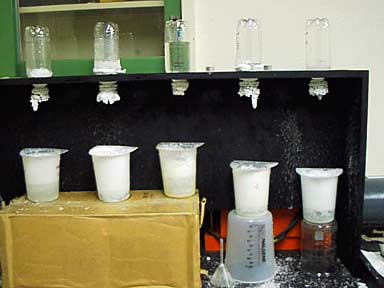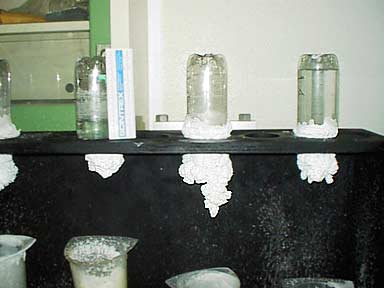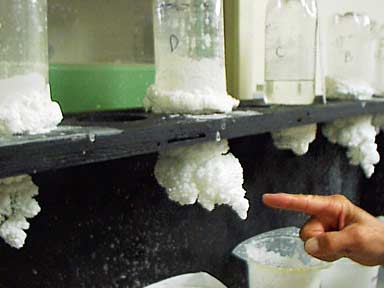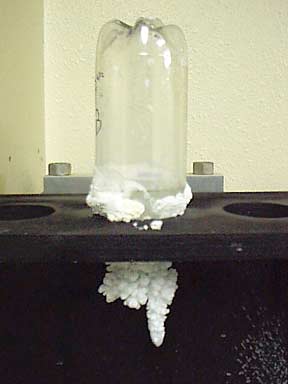
Grow Your Own Stalactites - Heres's How
We used regular store-bought table salt (NaCl). We put it in a large beaker full of deionized water and stirred the mixture with a magnetic stirring bar over night to make sure the solution was saturated (if not supersaturated) with salt (there was granular salt left over at the bottom of the beaker). The temperature of the lab was 75 degrees F. While the salt was dissolving, we took a 20-oz plastic pop bottle with a plastic cap and epoxyed coarse sand to the top of the cap so the stalactite salt crystals would have something to adhere to once they started growing. We drilled a small hole in the cap and a larger hole in the bottom of the bottle. (Actually, we made several bottles, because we wanted to test the flow rate of the salt-brine through different amounts of clay filters). We then added a filter paper between the cap and the bottle. Once the salt solution was prepared, we mixed measured amounts of illite clay with a small amount of saturated solution and poured the mixture through a funnel into the inverted plastic bottles. We put them on a stand so the clay mixture would settle to the filter paper and slow the dripping of the solution through the bottle cap. Once the clay had settled, we added more salt solution. Then we waited for the dripping to start. We added salt solution to the bottles as needed. We caught the dripped solution in beakers and recycled the liquid back into the beaker of saturated solution. Our lab was relatively warm and lacked humidity, so the stalactites started growing overnight (literally!). The pictures show stalactites we grew in less than two weeks.
Problems and observations concerning this technique include (1) the filter paper itself was more of a regulator of the rate of dripping than the clay we added, so choose your filter paper accordingly; (2) the salt solution wicked its way up the sides of the plastic bottles (can you figure out why?) before precipitating solid salt; (3) once the stalactites grew larger than a couple of hundred grams, they fell off the inverted bottles; (4) much of the precipitate was low-density fluffy "popcorn" -shaped solid rather than the hard, dense stalactites one sees in caves (can you tell us why?).
Two years ago, we intended this to be just an initial experiment, but we have yet to start a second round with differing conditions and/or starting materials. What conditions or materials do you think should be changed?

Stalactite apparatus as they begin to grow

Stalactite after two weeks of growth

Close-up of NaCl stalactite

Another close-up of stalactite

